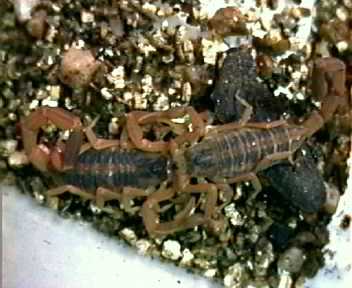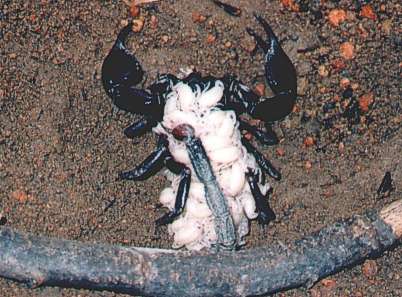Ask any man in the street what a scorpion is and probably you will be stared upon in
disbelief. Children from 8 years old to a 120 years old man would most likely have an idea
what a scorpion looks like. Or do they? Probe further on number of legs and many would
suddenly hesitate. Answers ranges from 3 pairs to a amazing 8 pairs!! To most layman who
lives in a concrete jungle of the cities, the number of legs a scorpion has doesn't
matter. The first image one conjured up would be that of the deadly venomous sting and the
pair of evil looking pincers. This is not help by the horrors Hollywood likes to generate
when using scorpions as their props. So what exactly is a scorpion?
Things covered are:
- Classification
- Distinguishing features
- Ancestry
- Number of species
- Size attainable
- Lifespan
- Prey and predator
- Distribution
- Behaviour
- Mating
Classification
It may surprise some that scorpions are arachnids which comprises of spiders,
harvestmans, mites, solpugids, whipscorpions, windscorpions and pseudoscorpions. A common
characteristic of the Class Arachnidae is that they possess 4 pairs of true legs and has
chelicera. There are many other characteristics not universally agreed upon and too
complex for the scope of general reader. A common misunderstanding is that scorpions are
insects. The truth is they are not but they belong to the same phylum Arthropoda.
How to distinguish a scorpion
Scorpions is distinct from the other arachnids in that their pedipalps are enlarged and pincer like. Another
distinctive feature is that they possess a tail-like abdomen part (metasoma) which ends in a sting (telson) which is not a
true segment. Other distinctive features includes the marked segmentation of the abdomen (opisthosoma) and the existence of the pectens. Outwardly, a scorpion resemble a crayfish with an
elongated tail.
'Ancestry'
The earliest scorpion fossil is found in the Paleozoic strata
430 million years ago. The ancestors bears great semblance to the modern day
representatives. The earliest Silurian scorpions appears to possess gills and are
postulated to be aquatic. They also grows to large size of about 1 metre in length
(compared to the 20+ cm for the biggest Hadogenes sp/Heterometrus sp). In the
period following the Silurian period, many species of ancestral scorpions are evolved
and these are amongst the pioneers on terrestial environment (though definitely not the
first). A noticable trait is that the scorpions through the millions of years has pectens like extensions and show remarkable conservation of
external morphology One of the
noted difference is the absence of claws (ungues) in the early euryterids.
Number of species.
Different sources, as you would notice, quoted different figures (700-1500)......
According to the yet-to-be-published catalog by Dr Fet et al, it stands at about 1260
species. Many others awaits discovery. The large difference in the number of species
quoted may be attributed to the scarcity of literature on scorpions, different date of
publication, their seclusive way of life and the great difficulty in distinguishing the
species. Except to trained eyes, many scorpions look very similar.
Mimicry and many other survival techniques employed by other animals
appears to be downplayed in scorpions. Their body colour is rather unimaginative and
ranges from yellow, brown, light green, dark blue, pale dull red to black. Most species
show none of the flamboyant coloration in many other arthropods.
Size attainable
The size of a adult scorpion typically ranges from half a inch to 8 inches. Pandinus
spp and Heterometrus spp (both about 7 inches or approx. 17.5cm) are probably the
heaviest (>30 grams) while male Hadogenes troglobyte has been measured to a
length of 21 cm (8.5 inches). The Bombay Natural History Society is said to hold a
specimen of Heterometrus swammerdami which measures a massive 24.7cm (9.75 inch)
but this has not been substantiated further from other experts.

A typical size attained by Emperor scorpion, Pandinus imperator,
The adult female is measured at about 12.5cm in length. Measurement
should be taken from the tip of the last metasoma (segment before the
telson) to the rostral portion of the prosoma. Refer to anatomy for more.
Age
Based on more recent findings, 2-8 years quoted by Dr Scott A. Stockwell(1997) for
Emperor scorpion Pandinus imperator should be closer to the mark. In the 'Biology
of Scorpions by Gary A. Polis (1990), the Pandinus imperator has one of the longer
lifespan(96 months) among the few studied. Other species generally has a lifespan of more
than 2 years as well.
The longevity of a scorpion in captivity is dependent on species,
individual, food, metabolism and disease. In the wild, only estimates can be made and
inter specific and intra specific predation comes into play. Again depending on source,
the maximum age attainable can be anything from 2-8 years to 2-30 years (similar to female
theraphosids?). It is also noted that a higher temperature, activity and food intake
significantly increases rate of maturation and reduce the lifespan attainable.
In a separate study by Shorthouse and Marples (1982) the maximum lifespan of extremely
long-lived Urodanus yashenkoi is 24 years!
Prey and Predator
All scorpions are predacious. Depending on locality, availabilty of food, species and
mainly size, a scorpion prey includes spiders, isopods, insects, myriapods(centipedes),
diplopods (millipedes), crabs, mice, birds, lizards, snakes........ The list goes on and
the general guideline is that a scorpion may take any creature smaller or equal to it's
size. Occasionally, they may even prey upon creatures larger than they are. This is made
possible by the venomous sting all modern scorpions possess.

Juvenile Heterometrus spinifer consuming a cricket.
The scorpion, despite it's thick armour, powerful pincers and venomous
stings, is not without predators. Mammals, frogs, salamander, other predacious insects,
spiders and especially birds preys upon scorpions. Some animals seems to have a partial
immunity against the venom of scorpions while others may have thick hides or fur to
prevent envenomation. Others devise numerous tactics to tackle this nutritious 'food
item'. It is known amongst most animals which eats scorpions that they attack the tail
first. This, in fact, is how many scorpion owners pick up our scorpion..
A very significant predator of scorpions is scorpions. Large scorpions prey upon smaller
scorpion and female scorpions sometimes eat it's unfortunate mate (except for some Tityus
spp where the reverse is true). This predation may be of the same species (intra
specific) or of different species (inter specific). Gary A. Polis in his studies of
sand scorpion, Smeringerus (Paruroctonus) mesaensis , observed that almost half of
the scorpions prey is scorpion themselves.
Human forms a special group in this interaction of predator and prey. Being neither (save
for the minority who eats scorpions as traditional chinese medicine {TCM} or as delicacy),
we nevertheless plays a pivotal role in their survival. In most case, our role is
destructive while in others we may have unconsciously created a new niche for the
adaptable scorpions. The impact of pet collection has not yet been significant but
systematic destruction of their habitat is threatening their survival.
Distribution
Scorpions can be found in the sea (littoral scorpions), in the mountains, in the
desert, in the tropics, in the caves and just about anywhere except perhaps the Arctic and
Antarctica. An interesting fact is that scorpions is found to even survive radiation from
French nuclear weapons test sites in Sahara (Bites and Stings, 1989)
Many can and do dig burrows to create a more conducive
'micro-habitat' which may partially explain their vast distribution. Contrary to some
books, most scorpions would not survive if exposed to extreme environment. Extreme heat or
cold kills them but the microhabitat within thier burrows buffers the effect allowing some
to survive.
Behaviour
Scorpion behaviour is not easy to characterise due to their diversity and
distribution. Most scorpions are nocturnal. Most are generally not aggressive to human
unless provoked. As information on scorpions are mostly concerned with its venom, not very
much studies is done on their life history, behaviour and sensory perceptions. The
increase in the popularity of scorpions as pets may change this but their behaviour in the
wild remains relatively unknown.
Mating
The mating promenade a deux of scorpion is well documented.
In most species, the males will exhibit juddering which is jerky up and down motion before
grasping the pincer (chelae of pedipalp) of the female with its
chelae. The juddering is thought to help create surface vibration as well as to increase
diffusion of the male pheromones. From personal observations, some species of scorpions (Heterometrus
sp.) also shows wavering of their metasoma. In some species eg. Hadogenes spp.
, the male will sting the female apparently to sedate the female. The male then pulls the
female towards itself. In a number of species, the chelicera
interacts with the female chelicera (chelicera massage). This however is not seen in all
species and on all occasions. While grasping the female's pincer, the male drags the
female to a suitable flat substrate (eg. flat rock) where it shows significant splaying
and movement of the pectens. This appears to suggest
that the pecten's mechanoreceptors are used to select suitable substrate. A drop of
spermatophore is then deposited from the genital papillae and the female is then dragged
to where the spermatophore is. The female genital operculum
'opens' and apparently this produces the suction to accept the spermatophore to the
genital orifice. This process may last from a few minutes (10 minutes in my specimens) to
a few days. After mating, in species whereby the male is smaller than the female,
predation by the female is not uncommon. However in Tityus trinitatus, the male
which is larger may prey on the female. This predation of males in most species in part
accounts for the higher ratio of females as the age increase. Another attributing factor
is that the male is more actively mobile especially during mating season and this results
in higher mortality from predation from other animals.

Centruroides vittatus showing chelicera massage.
The female is on the left and it can be seen that the male is grasping her pedipalp
as well

A female Heterometrus spinifer carrying her youngs (first
instars)on her back.
Despite their reputation, scorpions exhibit maternal instinct, uncommon amongst
arthropods.
Notice the larval orientation which has been a subject of interest in phylogenic study by
Savary.



